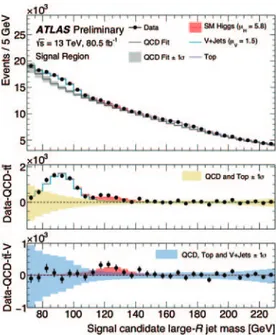DOI 10.1393/ncc/i2020-20073-8 Colloquia: IFAE 2019
IL NUOVO CIMENTO 43 C (2020) 73
Search for boosted H
→ b¯b decays in association with a jet using
pp collisions collected by the ATLAS detector
F. M. Follega
Department of Physics, University of Trento and TIFPA - Trento, Italy received 8 June 2020
Summary. — The H → b¯b channel has been studied to perform precision mea-surement of a Standard Model Higgs boson and to probe New Physics. It has been recently proposed to use events where the Higgs boson is produced in association with a high-pTjet, achieving more sensitivity for b-tagged jets from the Higgs decay.
In this work the latest ATLAS results will be shown about the search for 13 TeV events with a boosted Higgs decaying to b-pairs associated with a high-pT jet.
1. – Introduction
The analysis of events in which a boosted Higgs decays to b-quarks is particularly interesting to probe the existence of anomalous couplings at high pT, predicted by
sim-plified models or effective field theories [1]. Nevertheless, it presents multiple challenges that need to be addressed: a poorer mass resolution, when compared to the leptonic channels, a large background coming from QCD interactions, 107 times larger than the expected signal, and the presence of wide resonances (W and Z bosons) nearby the Higgs peak.
2. – Analysis strategy
The large-R jets are the physics objects used in this analysis, since the search is performed at high-pT regime (pT > 480 GeV) and the decay products tend to align
themselves along the Higgs boson flight direction. In order to reduce the overwhelming background and to require a boosted system, events with two large-R jets recoiling one against the other are required. The event selection is further optimized to pick large-R jets with signal-like features: the jets are required to contain at least two tracks with
pT > 10 GeV and to be boosted (2M/pT < 1). Afterwards, the leading large-R jet among
the selected ones in the event is chosen to be the signal candidate and the b-tagging is applied on the two jets built with tracks (track jets) associated. If both the tracks are
b-tagged the event goes in the SR, conversely if both the tracks are not b-tagged it goes
in the CR. Given the insufficient Monte Carlo statistics, a data-driven approach has
2 F. M. FOLLEGA
Fig. 1. – The predicted flavour composition of the dijet background large-R jets in the SR is shown on the left, where the B stands for b-quark, the C for c-quark and the L for light ones. The shape comparison between the dijet background in the SR and in CR is shown on the right.
been used for the QCD background estimation of this analysis [2]. For that reason, a parametric function which describes the distribution of the mass of the large-R jet has been fitted on the CR, and used to fit the distribution in the SR. Since the b-tagging efficiency is lower for small masses, the SR and CR mass distributions are different in this region, therefore the fit range has been chosen to start at 70 to exclude the turn-on. In fig. 1 the comparison between the SR and the CR and the flavor composition of the SR are shown.
SEARCH FOR BOOSTED H→ b¯b DECAYS IN ASSOCIATION WITH A JET ETC. 3
3. – Results
This analysis allowed to test the presence of pp→ H + jet and additionally to probe the existence of pp→ V + jet (V = W/Z) at high pT, using 80.5 fb−1 of pp collisions
at √s = 13 TeV recorded by the ATLAS detector. The result of the fit is shown in
fig. 2.
For the Standard Model Higgs boson, the observed signal strength is μH = 5.8±
3.1(stat.)± 1.9(syst.) ± 1.7(th.), which is consistent with the background-only hypothesis within 1.6 standard deviations. For the V , the observed signal strength is μV = 1.5±
0.22(stat.)± 0.29(syst.) ± 0.18(th.), corresponding to a significance of 5σ. The mass distribution has been used to search for other low-mass resonances decaying to b-pairs. No significant deviation from the only-background hypothesis has been observed. The results of this analysis are strongly limited by statistical uncertainty, which will be reduced by the use of the full Run 2 dataset in the future iteration.
REFERENCES
[1] Grazzini M., Ilnicka A., Spira M. and Wiesemann M., JHEP, 03 (2017) 115. [2] ATLAS Collaboration, ATLAS-CONF-2018-052 (2018).
